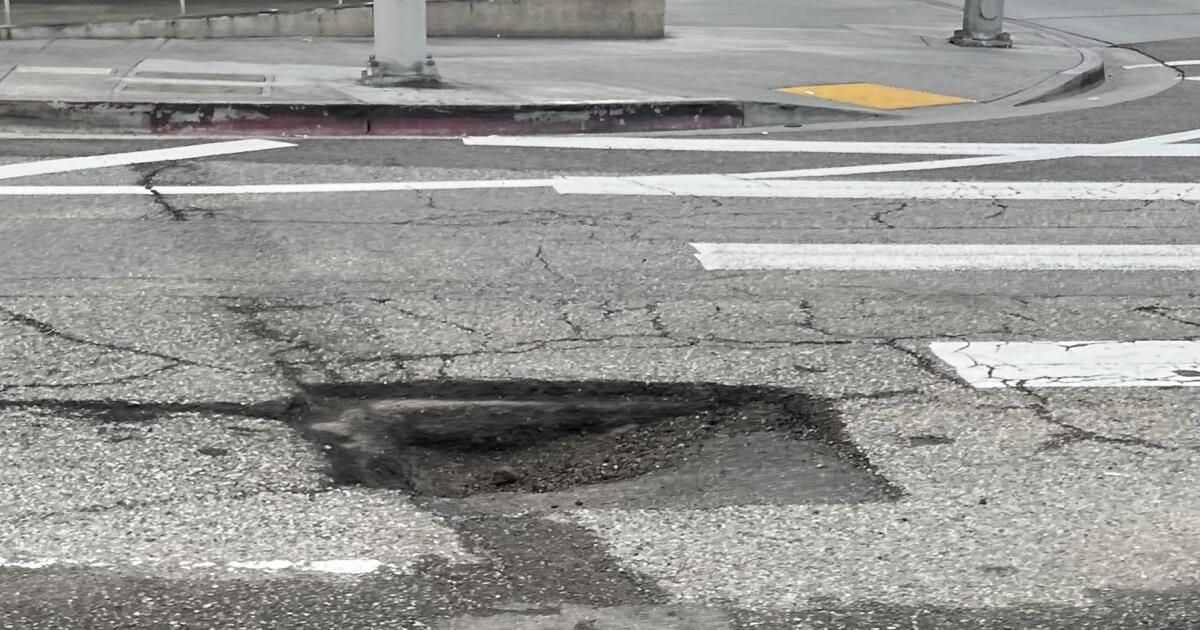There are more than 7,500 miles of streets in the city of Los Angeles.
Imagine how many potholes they will get after a few more days of heavy rain.
Driving over a pothole can damage a tire, rim, or axle; If the impact is severe enough, it can affect the vehicle's suspension, undercarriage, body, or even the frame. According to a new survey by the American Automobile Association, an estimated 44 million American drivers suffered damage from potholes last year, and an average of $406 was spent on repairs. Tires were the most common casualties, followed by vehicle alignment and wheels, AAA found.
If your ride has been sabotaged by a pothole hidden under a puddle of water or rendered invisible by an unlit street, you have ways to request reimbursement for the damage.
These are the steps you can follow.
Take the threat of potholes seriously
We all liked to splash in puddles as kids, but our cars don't have flexible joints. Plowing through a pothole can be Very badly for your vehicle. So the first line of defense is not to hit any of them. That means staying well behind the car in front, allowing you to see the road surface and react in time to avoid craters.
It also means keeping your tires properly inflated. Underinflated tires don't have as much air to absorb shock, so more of the damaging impact is transmitted to the suspension. Meanwhile, overinflated tires offer too little cushioning.
You may think you know the location of every pothole on the roads you drive on frequently, but rain has a way of creating new ones. Water seeps through cracks in the pavement, weakening the layers beneath the surface. As vehicles hit these spots again and again (rain tends to wash out more cars, not fewer), the weakened areas become larger and larger holes.
That's why it's hard to avoid potholes, even on routes you know well. When you're about to hit one, take your foot off the accelerator and don't brake, experts advise. This is because stepping on the brakes tends to compress the suspension and lower the nose of the vehicle, giving the suspension less room to absorb the shock.
Don't go astray either, advises the auto parts chain TiresPlus.
“Swerving into the bump at an angle can cause the front tire to sharply hit the edge. This can cause greater damage than driving directly over the pothole,” TiresPlus says on its website. “Even more importantly, swerving wildly can mean leaving the lane of traffic or leaving the road, two scenarios that can have much worse outcomes than simply hitting a pothole.”
Be sure to fix small pothole-related problems right away.
“Look for changes in vehicle handling, excessive vibration, or uneven tire wear, all signs of a problem with the suspension, such as alignment or shock absorbers,” AAA advises. “If your vehicle pulls to the left or right, have your wheel alignment checked by a trusted mechanic.”
And if you see a pothole, report it. The Times' Shape Your LA app can show you how to report a pothole that needs fixing (or any other everyday concern) to your city government, so you and everyone else can drive with a little less anxiety.
File a car insurance claim
This option is available only if you pay for collision coverage, which is not required. According to the Insurance Information Institute, this covers “damage to an automobile resulting from a collision with an object (for example, a pothole, light pole, or guardrail), another automobile, or as a result of a rollover. However, it does not cover wear and tear on a car or its tires due to poor road conditions.”
However, there are at least two reasons not to file a claim. First, you may have set your deductible relatively high, such as $500 or $1,000, to keep your premiums low. If the cost of your repairs is less than or equal to your deductible, your insurance will pay nothing.
Second, if your claim is large enough to generate a payout, your insurer will likely try to recoup its cost over time through higher premiums.
“Since hitting a pothole is considered a single-vehicle accident, your insurer will generally hold you at fault for the incident unless there is evidence that another vehicle caused you to hit the pothole,” Progressive Insurance says on its website. “Although your insurance provider will cover damages if you have collision coverage, you may see an increase in your insurance rates at renewal time.”
File a lawsuit against the government.
State law holds the government responsible for dangerous conditions on public property, but only if the government knew or should have known about them. So if you file a claim against a city, county, or state, you should be prepared for a fight to get a refund.
Any claim must be submitted within six months of the damage occurring.
Attorney Allen Patatanyan, managing partner of West Coast Trial Lawyers, said some things will need to be proven to establish government liability. But proving that the government was or should have been alert about the pothole before his accident “is a very, very big issue,” he said.
The law provides two ways to do this. One is to prove that the government had been informed about the pothole or had detected it during an inspection, Patatanyan said. The other tactic, called “constructive notice,” is to establish that the government would have known about the pothole if it had had a reasonable inspection routine.
Finding out if the government knew about a pothole usually requires a public records request to compile all complaints received about that particular road, along with accident reports and inspection records. Los Angeles gets a lot of complaints: The Department of Public Works said it received 5,869 pothole repair requests in the first three weeks of March alone. The department said its crews had repaired nearly 4,000 of them, leaving about 30% uncovered at the time. And that's just because of the latest complaints.
Unless you can point to complaints, accidents, or inspection records that alerted the government to a pothole, you must prove that the government should have known. That's the kind of thing an expert witness would use to argue in court, Patatanyan said.
Circumstances matter too. For example, one could argue that after heavy rains, the government should have stepped up inspections of roads with aging pavement.
In any case, the first step in filing a claim is determining which government entity is responsible for maintaining the road you were on when you hit that pothole.
- Los Angeles and other large cities are responsible for potholes on streets (but not highways) within their boundaries. Here is a link to the Los Angeles claim form.
- Counties are responsible for streets in unincorporated areas and in smaller cities that pay the county to maintain them. Here is a link to the Los Angeles County claim form.
- Caltrans, the state transportation department, is struggling with potholes on federal and state highways.
For Caltrans claims of $10,000 or less, download a form and then submit the completed version to the Caltrans District Claims Office serving the county where the pothole is located. For Los Angeles and Ventura counties, that office is on the 13th floor at 100 South Main St. in Los Angeles. For claims over $10,000, Caltrans directs you to request a form by writing to: Government Claims Program, Office of Risk and Insurance Management, Department of General Services, PO Box 989052, MS 414, West Sacramento, CA 95798-9052.
The forms request names of witnesses and invite you to submit evidence that supports your claim, such as repair invoices. Although they don't specifically ask you to prove that the government knew or should have known about the pothole, each form has a section that asks you to explain why you think the government is responsible.
For example, the City of Los Angeles form asks: “What particular ACT or OMISSION do you claim caused the injury or damage?” The state form asks: “What do you claim Caltrans or its contractor did to cause you injury or damage?”
Progressive Insurance warns that it can take a long time to prevail on a claim against the government, “so if your vehicle is undrivable, it may make more sense to file an insurance claim for the pothole damage or pay for repairs out of pocket.” and then request a refund from the city later.” However, note that any claim must be filed within six months of the pothole strike.
The larger your claim, the more likely the government will reject it, at which point you will have to go to court for reimbursement. In particular, Patatanyan said, if a claim is filed where injuries are involved, “that's when the fight begins.”
About the Times public service journalism team
This article is from The Times' public services journalism team. Our mission is to be essential to the lives of Southern Californians by publishing information that solves problems, answers questions, and helps with decision-making. We serve audiences in and around Los Angeles, including current Times subscribers and diverse communities whose needs have historically not been met by our coverage.
How can we be helpful to you and your community? Email utility (at) latimes.com or one of our journalists: Jon Healey, Ada Tseng, Jessica Roy and Karen García.










